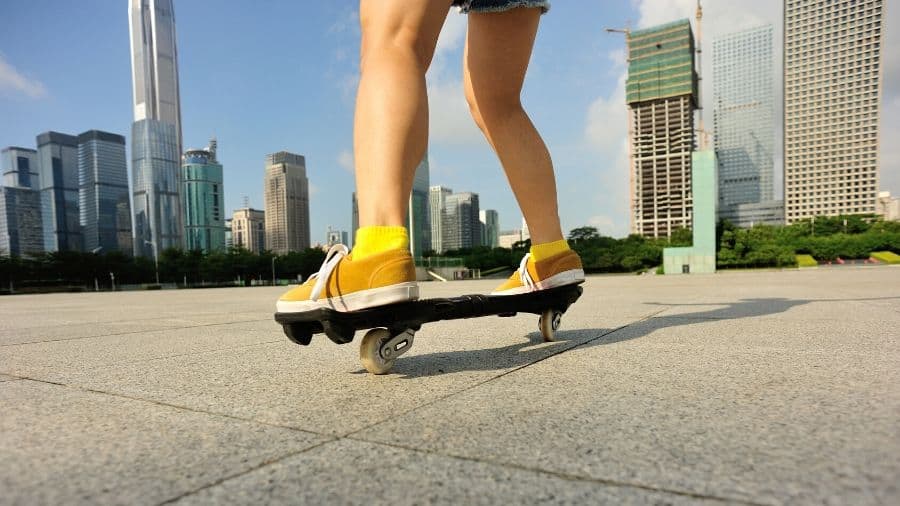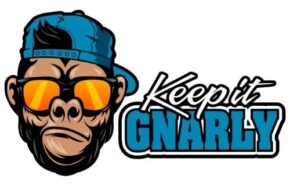
Is snowboarding like ripsticking? One is a summer sport on two wheels, the other is a winter sport with an edge. The similarities between the two are surprising yet obvious.
Riding a ripstick is more like snowboarding than skateboarding or longboarding. Although they are all ridden with your dominant foot at the back, a ripstick doesn’t require any pushing. The feet stay on the board at all times as if locked in by bindings. With a motion the most similar to carving that you can get on dry land, the hips propel the board forward.
So, how does this work? There are no edges on a ripstick, how is it possible that it’s like snowboarding on dry land? Read on and you’ll find out exactly why.
Table of Contents
Why is Ripsticking Like Snowboarding?
As a snowboarder, you know the importance of carving. Even when you just want to point the board and go, the only way to gain control is to have the board on an edge. It’s why we love it. The carve can be long and sweeping, or short and controlled, but it’s the entire reason to snowboard. Carving with the music pumping and friends by your side is really the best feeling in the world.
Ripsticking provides the same feeling with the same motion. There’s no reason to push. With the hips loose and a sweeping motion, you can move the board forward. Even stopping is like on a snowboard, with the back foot coming fast to join the front perpendicular to the direction of movement. It’s a really flowing ride with the rider able to lean back and forward to carve, just like the cushy ride of a snowboard. It also lets you carve tight and control the board, unlike a skateboard and exactly like a snowboard.
With the feet locked in, performing tricks on the ripstick is a cross between snowboarding and skateboarding. Manuals are the same and can be done off the front or back foot. An ollie is the cross between a snowboard and a skateboard and can be done moving the front foot or not (riders choice). Nollies are possible as well. Even buttering (a manual where the rider turns on the single pivot point underneath their foot) can be done on a ripstick. Block stalls and rails are possible as well as a kickflip, giving the rider a lot of different trick combinations and blurring the lines between snowboarding and skateboarding.
In the park, no pushing means the lines need to be ridden like a snowboard. The flow of the park with the rider choosing lines based on hills and how to gain speed makes for a pretty ride through the skatepark. It changes how the skatepark looks and opens up a world of creativity. The rider has to look at a skatepark like a snowboard park, and this can make even the oldest parks look new and fun again.
Is the First Day of Ripsticking the Same as Snowboarding?
Even learning to ripstick presents the same challenges as snowboarding. Anybody who picked up a snowboard a bit later in life knows the struggle of trying to stand up from your butt the first day.
The bunny hill is full of people trying to stand, while the learn-to-skiers fly by with their “pizza” or “French fries”.
At least on a skateboard, a beginner can stand. They may crash and fall, but they can stand up and roll. Not the case with a ripstick.
If the balance isn’t there, there’s no moving. There’s a lot of falling and frustration at the beginning, exactly the same as snowboarding. But, also like snowboarding, the end result is worth it.
Ripsticking provides the freedom of the road and doesn’t require tricks to have fun. Much like a blue run on the snowboard hill, even just cruising down the street with the cushy carve makes the ride worthwhile.
Is a Ripstick like a Snowboard?
Despite some minor similarities, a ripstick and a snowboard are very different beasts, you can’t snowboard on a ripstick and you cant ripstick on a snowboard.
Ripstick: a two-wheeled skateboard with two flat plastic ends separated by a torsion beam.
Also called a Caster Board, different companies have different brand names. There’s the Ripstick by Razer, the Waveboard by Street Surfing, and other knock off brands available for sale. However, the Ripstick is THE caster board, monopolizing the Best Seller lists. The ripstick was put on the market in 2006 and has been the most popular of all the brands for almost 15 years.
A snowboard on the other hand is typically made of laminated fiberglass around wood. Poplar and Beech are the most common woods used, although bamboo and birch are also used. The most popular brand on the market is Burton.
Is Ripsticking Expensive Compared to Snowboarding?
Relative to snowboarding, no, not at all. Most skateparks are free, there’s no lift ticket to purchase for your front street. It’s comparable to skateboarding, with a Ripstick board costing between 100$-150$.
Given that a snowboard with boots and bindings can run about 500$, this is a much cheaper option. Plus, if a glacier isn’t in your immediate vicinity, snowboarding in the summer may not be an easy endeavor. The Ripstick gives you the option, at a much cheaper price than a longboard.
How to Start Ripsticking
Go buy one. Your non dominant foot (left if you’re regular, right if you’re goofy) goes at the front of the board. Unlike a skateboard, there’s no moving a ripstick without some balance.
A strong push off the dominant foot gets the caster wheels aligned. Then the rider can put their back foot onto the board and start carving. Without the strong push with the front foot on the board, the caster wheels (free spinning wheels like a desk chair) won’t align, making carving and moving on the board impossible.
Why you Should Ripstick if you Enjoy Snowboarding
If you like to snowboard and miss the hill, a ripstick is a really good way to get the feel of a snowboard during the summer.
It’s also cheaper than a snowboard, so there’s no hefty starting fee to get ripping.
If there’s an old skateboard park near your house, a ripstick lets you explore it in a new way. With no pumping, the lines in a park are completely different.
If you want to get a handle on carving during the offseason, then a ripstick lets you practice when there’s no snow. If you’re new to snowboarding and want to get a head start on the season, learning to carve on a ripstick is the most similar to snowboarding and lets you practice the hip motion in your driveway.
It’s a great way to get from point-a to point-b and gives the cushy snowboard ride at a fraction of the cost. If you’re not sure about a big mountain trip with friends and worried about the cost, grab a ripstick and spend a few days practicing. You’ll figure out if snowboarding is right for without the big associated cost of a lift ticket or gear rental.
Really, for the price point, there’s no reason not to get outside and carve. Blast some tunes (make sure you can still hear traffic), grab some friends, and start carving. Your snowboard game will thank you come season time.
My Favourite Ripstick
- Ripstik Caster Board (Amazon Link)
